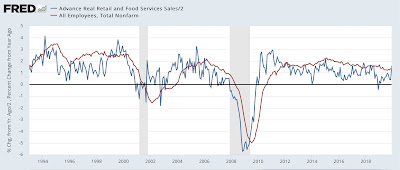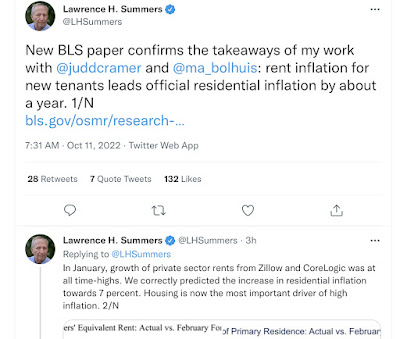- by New Deal democrat
I just finished reading Susan Wise Bauer’s “The History of the Ancient World,” which in a little under 800 pages summarizes an almost endless string of kings and battles from the earliest written records kept by the Sumerians around 3000 BC through the accession of Constantine as Roman Emperor in 306 AD.
It is timely to consider it in reference to Indigenous Peoples’ Day in the US, as what both have in common is the centrality of big migrations of humanity to conflict and the rise and fall of civilizations. The migration of many millions of people primarily from Europe, but also some from Asia, and also the involuntary importation of slaves from Africa to the Americas, is one of the largest such displacements ever, but large movements of people have been going on since the dawn of humanity, and continue now (as, for example, the migrations from Latin to North America, and from North Africa and the Middle East to Europe) - and with similar problems.
Indeed, the history, and indeed pre-history of humanity seems largely centered on such migrations.
About half a year ago I completed and reviewed “The Dawn of Everything,” an extensive review of human prehistory for the past 30,000 or so years, contrasting it with Yuval Noah Harari’s “Sapiens.” Here is a little of
what I wrote then:
“Why did “civilization” begin? I think Harari has the better argument. Graeber and Wengrow think that civilization drives population growth; but the evidence is most consistent with the reverse causation, i.e., population growth drove the necessity for more organized and permanent food production, and for denser and permanent living arrangements. Harari notes just how exponential long term human population growth has been. Only 2500 years ago, during the golden age of Athens or the first Chinese dynasty, human population was only about *1%* of what it is now.
“In any event, [“The Dawn of Everything” makes] a good argument that historically the default government for most human populations hasn’t been dynasty or autocracy, but rather small-scale Republics, with pre-set rules and public participation (Vindication for John Rawls!).”
Bauer picks up just about where “The Dawn of Everything” leaves off. The latter uses archeology and anthropology to sketch what human civilization looked like before writing came into use. Bauer explicitly uses writing as her dividing line between pre-history and history. She starts with, and almost exclusively bases her narrative upon, written records, the first of which were made by the Sumerians about 5000 years ago. Because she explicitly limits discussion to those cultures with written records, there is no discussion of life in the Americas, Australia, or sub-Saharan Africa, nor of the northern tribes of Eurasia. Rather, the focus of the book expands as the use of writing expands, from ancient Mesopotamia to Egypt to India and China, then to the Jews, Greeks, Macedonians and Romans.
I do wish she had partnered with an archeologist, because apparently what ancients most wrote about (probably paid by their sovereigns) was the rise of and battles won by their kings, and the losses of everybody else’s kings. Cities are founded, rise, apparently prosper, and then are seized, sacked, or razed, in some cases such as Babylon many times over (one Assyrian goes so far as to not just raze Babylon, but to divert river water through the remains to turn it back into the swamp it was before it was founded. And then within 100 years it is built again). One is left to wonder why humans continued to found, and live in, cities, since they were such targets for the kingdom next door. Presumably because they were better than the wandering, nomadic alternative for most people. They must have been *relatively* prosperous and secure. A fuller fleshing out from the available archeological evidence would have been a very welcome addition.
But among the ceaseless battling, rising, and falling, there are some overarching themes in “The History of the Ancient World:”
1. There have always been large migrations of humanity.
2. They seem to be driven by both increased population and climate change.
3. Also because, in groups, humans are a**holes.
Almost all of these migrations during the period examined by Bauer are from the north. Wandering tribes found kingdoms to the north of China, northwest of India in Central Asia, in the Caucasus mountains, Asia Minor, Macedonia, and north of the Alps, and then migrate - or at least attempt to migrate - south into the “more civilized” established polities. The only instance of a threat from the South during the entire 3300 year period covered by Bauer is when the Nubians of modern day Ethiopia attack an Egyptian dynasty to their north.
Bauer does allude to climate change, partly in terms of the ability to practice agriculture in certain areas, and partly as to changing coastlines over time, e.g., the gradual increase in the size of the northern Persian Gulf, the flooding of the freshwater Black Sea, and the isolation of Great Britain from the European continent. There is also an element of over-farming, as ancient fields in the Tigris and Euphrates plains gradually salt up and fail.
But this pattern of migrations and invasions from the North is so universal that there is likely a dominant explanation. Perhaps the warming of the climate over time allowed for a *relative* bigger population increase in the sub-Arctic areas. And that increased population had to spread out somewhere. Indeed, the population on the island of Crete became so dense that 1/2 of those just reaching maturity were chosen by lot and ordered to leave the island on boats to found colonies elsewhere. The more established and fertile lands to the South seem to have been the answer - and created endless conflict as those established civilizations sought to keep the northern invaders out. And if they didn’t, they too migrated, as when some Phoenicians allied with the biblical Jezebel fled to North Africa and founded the city of Carthage. Or when the Goths and other Germanic tribes fled south into the Roman Empire in response to the Vikings’ incursions south from Scandinavia.
Also, the increased population gave rise to larger and larger empires, as successful systems of bureaucracies evolved. The first recorded empires covered northern Mesopotamia and north and south Egypt. Similarly, the first big kingdom in China only covered a portion of the northern interior. But by 300 AD, three large empires span the Eurasian continent from west to east: Rome, Persia, and China; and the Silk Road moved money and goods among them.
There is very little evidence of peaceful co-existence, or absorption of the new settlers into existing society. When population pressures get too much, or when a faction is subject to repeated violence, they leave, and try to re-settle in areas at a sufficient distance away to avoid contact with their former neighbors. I.e., in societal groups, by and large humans are a**holes. Shades of Trumpists today!
When successful, these conquests give rise to new civilizations, such as the Hittites of Asia Minor, or the Bactrian Greeks (from Alexander’s conquests) in eastern Persia, and northwest India. And of course, the same explanation for the migration of European religious minorities and those seeking new fortunes to the Americas after 1492, founding a new civilization and displacing and committing near genocide against the existing inhabitants, the Indigenous Americans that were honored by the holiday yesterday.
One final note: we owe a historical debt of gratitude to one ancient nerd in particular: the Assyrian King Ashurbanipal of Nineveh, in what is now northern Iraq, who reigned from 668-626 BC. Apparently alone among ancient monarchs, he made the collecting and copying all sorts of written clay tablets from across his empire a priority. These included “spells, prophecies, medical remedies, astronomical observations, stories and tales (including … the ancient hero Gilgamesh).” These were all put together in an imperial library at Nineveh, which according to Bauer held “almost thirty thousand tablets.”
Just like every other civilization, ultimately Nineveh fell, and was put to the torch. But unlike papyrus scrolls, such as those thousands destroyed in the burning of the library of Alexandria in Egypt, when clay tablets are burned, they turn to brick stone. Buried in the rubble, they remained largely intact, to be discovered during an archeological excavation during the 19th century. And available to historians like Bauer and ultimately to us, an empire of the mind that forms most of the written record of what we now know about the ancient civilizations from the beginnings of Sumeria 5000 years ago.




























